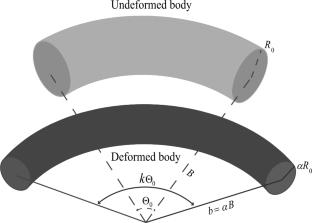不可压缩各向同性物体的普遍变形注记
IF 1.4
3区 工程技术
Q2 ENGINEERING, MULTIDISCIPLINARY
引用次数: 0
摘要
本研究提供了一个例子,证明了普遍变形并不约束物体的形状。我们证明了弯曲、膨胀、方位剪切和环面扇形主半径的膨胀或收缩属于第5类变形。因此,不可压缩各向同性固体的通用变形并不局限于环形楔。所提出的例子被证明是一类非齐次变形,其中柯西变形张量具有恒定的主不变量-这一性质仅在5类变形中发现。本文章由计算机程序翻译,如有差异,请以英文原文为准。

A Note on the Universal Deformations of Incompressible Isotropic Bodies
This study provides an example demonstrating that a universal deformation does not constrain the shape of a body. We show that bending, inflation, azimuthal shearing, and expansion or contraction of the major radius of a toroidal sector belong to the class of Family 5 deformations. Therefore, this family of universal deformations for incompressible isotropic solids is not restricted to an annular wedge. The proposed example is shown to be a family of inhomogeneous deformations in which the Cauchy deformation tensor has constant principal invariants — a property which is found only in the Family 5 class of deformations.
求助全文
通过发布文献求助,成功后即可免费获取论文全文。
去求助
来源期刊

Journal of Elasticity
工程技术-材料科学:综合
CiteScore
3.70
自引率
15.00%
发文量
74
审稿时长
>12 weeks
期刊介绍:
The Journal of Elasticity was founded in 1971 by Marvin Stippes (1922-1979), with its main purpose being to report original and significant discoveries in elasticity. The Journal has broadened in scope over the years to include original contributions in the physical and mathematical science of solids. The areas of rational mechanics, mechanics of materials, including theories of soft materials, biomechanics, and engineering sciences that contribute to fundamental advancements in understanding and predicting the complex behavior of solids are particularly welcomed. The role of elasticity in all such behavior is well recognized and reporting significant discoveries in elasticity remains important to the Journal, as is its relation to thermal and mass transport, electromagnetism, and chemical reactions. Fundamental research that applies the concepts of physics and elements of applied mathematical science is of particular interest. Original research contributions will appear as either full research papers or research notes. Well-documented historical essays and reviews also are welcomed. Materials that will prove effective in teaching will appear as classroom notes. Computational and/or experimental investigations that emphasize relationships to the modeling of the novel physical behavior of solids at all scales are of interest. Guidance principles for content are to be found in the current interests of the Editorial Board.
 求助内容:
求助内容: 应助结果提醒方式:
应助结果提醒方式:


